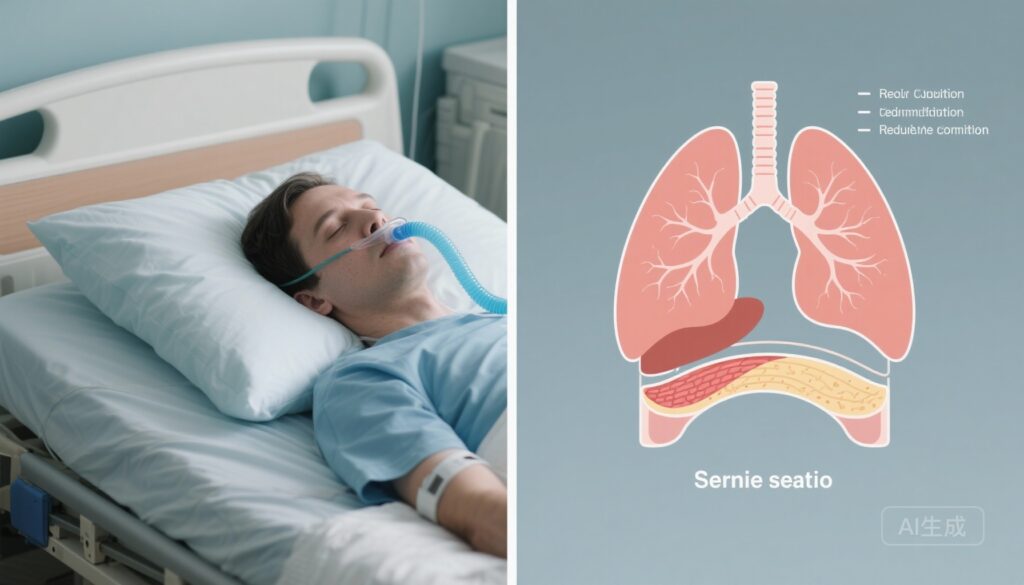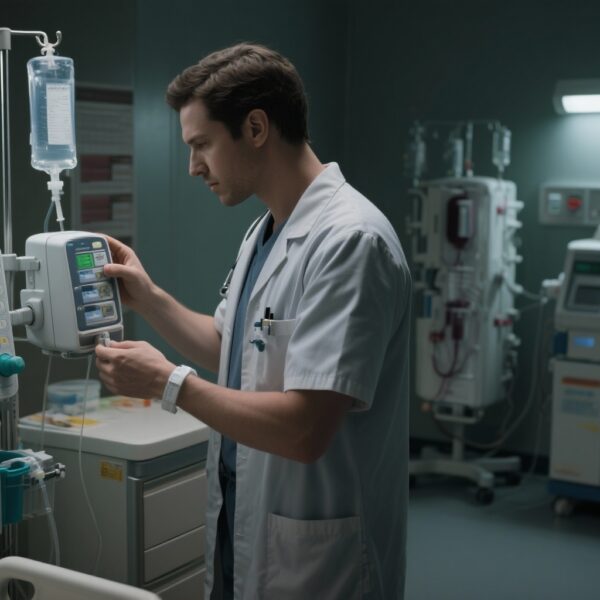Highlight
– Increasing trunk inclination during passive mechanical ventilation reduces respiratory system, lung, and chest wall compliance; effects are larger in patients with obesity.
– Only obese patients demonstrated a clinically meaningful rise in arterial CO2 (PaCO2) with increased trunk inclination.
– No consistent change in oxygenation (PaO2/FiO2) was observed across groups; study heterogeneity limits definitive practice recommendations.
Background
Body position is a modifiable determinant of respiratory mechanics in critically ill, mechanically ventilated patients. Acute respiratory distress syndrome (ARDS) is characterized by heterogeneous lung involvement, and patient positioning influences transpulmonary pressure distribution, functional residual capacity, and airway closure. The interaction of trunk inclination with the chest wall, diaphragm, and abdominal contents may be particularly relevant in patients with obesity, who have altered baseline chest wall mechanics and elevated intra‑abdominal pressure. Understanding how routine changes in bed inclination affect lung and chest wall compliance and gas exchange may help clinicians individualize ventilator settings and bedside positioning.
Study design
This article reports a secondary analysis pooling individual physiologic data from seven previously conducted studies collecting trunk‑inclination responses in sedated, passively ventilated ARDS patients. The pooled cohort included 159 patients divided by body mass index (BMI): 65 patients with obesity (BMI ≥ 30 kg/m2) and 94 without obesity (BMI < 30 kg/m2). Physiological endpoints compared between lower and higher trunk inclination angles included respiratory system compliance, partitioned lung and chest wall compliance, arterial carbon dioxide tension (PaCO2), and oxygenation (PaO2/FiO2). The analysis focused on acute within‑patient changes associated with increasing trunk angle.
Because the dataset represents a secondary analysis of heterogeneous primary studies, ventilator modes, PEEP levels, measurement techniques, and exact inclination angles varied between studies. Patients were passively ventilated and sedated, limiting confounding from spontaneous respiratory efforts.
Key findings
This pooled analysis reports several consistent physiologic effects of increasing trunk inclination, with more pronounced changes in obese patients. Reported effect sizes (median [interquartile range]) and p values below reflect the pooled within‑patient changes described by the authors.
Respiratory system compliance
Both groups experienced reductions in respiratory system compliance with increased trunk inclination. The decline was greater in patients with obesity: median change −7.5 mL/cmH2O (IQR −10 to −5); p < 0.001, compared with non‑obese patients −3.5 mL/cmH2O (IQR −7 to −0.08); p = 0.045. These findings indicate a statistically significant and clinically relevant loss of compliance after raising trunk angle, particularly in the obese subgroup.
Lung and chest wall compliance (partitioned mechanics)
Partitioning the respiratory system clarifies that both lung and chest wall components contribute to the net compliance change, but with different patterns by BMI. In obese patients lung compliance decreased (−7.8 mL/cmH2O; IQR −12.4 to −3.3; p < 0.001). Non‑obese patients did not have a significant change in lung compliance (−5.9 mL/cmH2O; IQR −14.2 to 2.3; p = 0.160).
Chest wall compliance decreased in both groups: obese patients −42.9 mL/cmH2O (IQR −63.2 to −22.6; p < 0.001) and non‑obese patients −47.7 mL/cmH2O (IQR −95.3 to −0.15; p = 0.049). The large reductions in chest wall compliance confirm that trunk inclination has a major effect on the mechanics of the thoraco‑abdominal wall, regardless of BMI, but the lung component appears to be more susceptible in obesity.
Gas exchange: PaCO2 and oxygenation
PaCO2 increased significantly in obese patients following increased trunk inclination: +4.6 mmHg (IQR +1.4 to +7.8; p = 0.004). In non‑obese patients, PaCO2 change was not statistically significant: +2.5 mmHg (IQR −0.6 to +5.6; p = 0.113). These data suggest impaired alveolar ventilation or increased dead space effect with trunk elevation in obese patients.
There were no significant or consistent between‑phase differences in oxygenation measured as PaO2/FiO2 in either subgroup in this pooled analysis.
Clinical interpretation of effect sizes
A reduction in compliance of several mL/cmH2O may seem numerically modest, but in the context of lung‑protective ventilation where tidal volumes are small, even incremental declines in compliance can increase delivered driving pressures and alter stress distribution. The observed 4–5 mmHg rise in PaCO2 in obese patients is clinically meaningful, particularly in ARDS where minute ventilation targets and permissive hypercapnia are managed deliberately to maintain safe airway pressures. These physiologic shifts warrant awareness when changing bed inclination in this population.
Expert commentary and mechanistic considerations
Mechanistically, increasing trunk inclination (moving from flat to semi‑recumbent positions) shifts abdominal contents caudally relative to the thoracic cavity and redistributes diaphragmatic curvature and pleural pressures. In obese patients, higher baseline intra‑abdominal pressure and increased adipose mass compress the dependent lung regions, reduce end‑expiratory lung volume, and stiffen the chest wall. When the trunk is raised, the chest wall geometry changes more markedly in obese individuals, potentially causing greater reductions in transpulmonary pressures in dependent regions and promoting small‑airway closure and regional derecruitment—hence reduced lung compliance and higher PaCO2 due to loss of ventilated lung units.
Chest wall compliance declined in both BMI groups, consistent with altered rib‑cage mechanics and diaphragmatic position with trunk elevation. That lung compliance fell mainly in the obese subgroup suggests amplification by obesity‑related factors (higher abdominal mass, reduced diaphragmatic excursion, increased pleural pressure gradients).
These findings align with prior physiologic literature describing the impact of body habitus and positioning on respiratory mechanics (e.g., Pelosi et al. on positioning effects in obesity) and complement established ARDS care principles such as lung‑protective ventilation and prone positioning when indicated (PROSEVA trial demonstrated survival benefit of prolonged prone positioning in severe ARDS). The present data underscore that simple bed inclination adjustments can meaningfully alter mechanical variables clinicians use to set and titrate ventilators.
Limitations
This analysis has important limitations that temper immediate practice changes. The dataset is a secondary pooled analysis of seven heterogeneous studies: measurement techniques, PEEP and tidal volume strategies, exact trunk angles, and timing varied across centers. All patients were passively ventilated, so results may not extend to patients with spontaneous breathing efforts. The analysis reports acute physiologic changes but not clinical outcomes such as duration of ventilation, ventilator‑associated complications, or mortality. Finally, some confidence intervals are wide (especially for chest wall compliance in non‑obese patients), reflecting variable sample sizes and measurement noise.
Clinical implications and practical recommendations
For clinicians managing ventilated ARDS patients, the findings suggest the following practical points:
- Be aware that increasing trunk inclination can reduce overall respiratory system compliance and may raise PaCO2, particularly in patients with obesity.
- When changing bed inclination, reassess airway pressures (plateau and driving pressure), delivered tidal volumes, and end‑tidal or arterial CO2 to identify clinically relevant effects and adjust ventilator settings as needed to maintain lung‑protective targets.
- Consider that semi‑recumbent positioning has recognized benefits for aspiration prevention and central line infection reduction; these benefits must be weighed against possible adverse effects on mechanics and ventilation in obese patients. Individualized trade‑offs are appropriate.
- In patients with rising PaCO2 after trunk elevation, evaluate options including adjusted minute ventilation (if lung‑protective plateau pressure limits allow), transient return to a lower inclination angle, recruitment maneuvers or PEEP titration, or consideration of prone positioning if oxygenation/ventilation remains suboptimal and criteria are met.
Research and guideline gaps
Prospective randomized or crossover physiologic trials with standardized measurement protocols are needed to confirm these observations and define thresholds for clinically meaningful change. Future studies should include patients with spontaneous effort, evaluate longer‑term effects of repeated or prolonged positioning changes, and investigate outcome measures such as ventilator‑free days and mortality. Examination of optimal PEEP settings and recruitment strategies when changing trunk inclination in obese patients would also be valuable.
Conclusion
This pooled secondary analysis shows that increasing trunk inclination during passive mechanical ventilation reduces respiratory system, lung, and chest wall compliance, with larger effects in patients with obesity. Only the obese subgroup demonstrated a statistically significant increase in PaCO2. Given methodological heterogeneity across the included studies, these findings are hypothesis‑generating but clinically relevant: bed inclination is not a neutral intervention in ventilated ARDS patients and should be considered a modifiable factor that can affect mechanics and gas exchange—especially in obesity. Clinicians should monitor ventilatory variables when changing trunk angle and individualize positioning strategies.
Funding and clinicaltrials.gov
Funding details for the pooled analysis were not provided in the summary; readers should consult the original publication for specific funding statements and trial registration. Primary studies included in the pooled dataset have variable funding and registration status as reported in their respective publications.
Selected references
– Benites MH, Bihari S, Battiato R, Bruhn A, Bugedo G, Costa ELV, et al. Respiratory effects of trunk inclination in obese and non-obese patients mechanically ventilated for ARDS. Crit Care. 2025 Oct 28;29(1):457. doi: 10.1186/s13054-025-05694-z. PMID: 41152895; PMCID: PMC12570651.
– The ARDS Network. Ventilation with lower tidal volumes as compared with traditional tidal volumes for acute lung injury and the acute respiratory distress syndrome. N Engl J Med. 2000;342(18):1301–1308.
– Guérin C, Reignier J, Richard JC, Beuret P, Gacouin A, et al.; PROSEVA Study Group. Prone positioning in severe acute respiratory distress syndrome. N Engl J Med. 2013;368(23):2159–2168.
– Pelosi P, Croci M, Ravagnan I, Tredici S, Pedoto A, Lissoni A, Gattinoni L. The effects of body positioning on lung volumes and arterial oxygenation in spontaneously breathing obese patients. Anesthesiology. 1998;89(1):112–119.
Original study citation
Benites MH, Bihari S, Battiato R, Bruhn A, Bugedo G, Costa ELV, Dellamonica J, Guérin C, Langer T, Marini JJ, Marrazo F, Mezidi M, Selickman J, Wiersema UF, Retamal J. Respiratory effects of trunk inclination in obese and non-obese patients mechanically ventilated for ARDS. Crit Care. 2025 Oct 28;29(1):457. doi: 10.1186/s13054-025-05694-z. PMID: 41152895; PMCID: PMC12570651.



